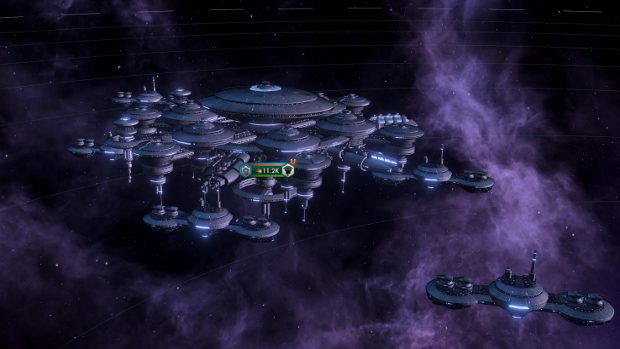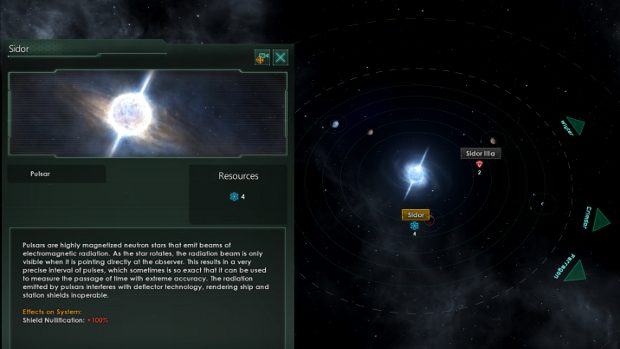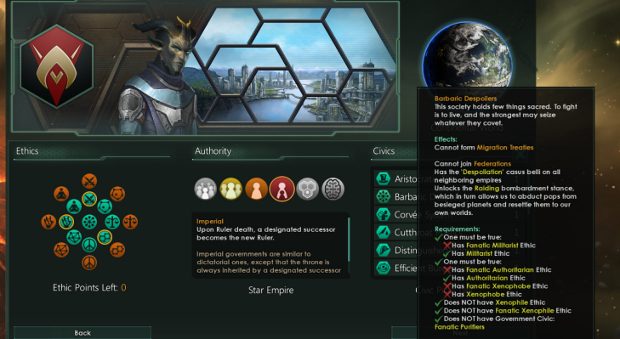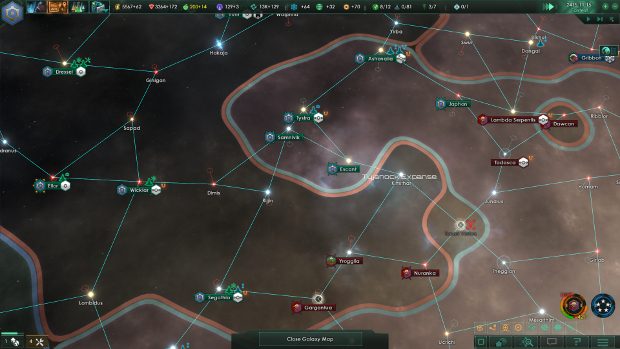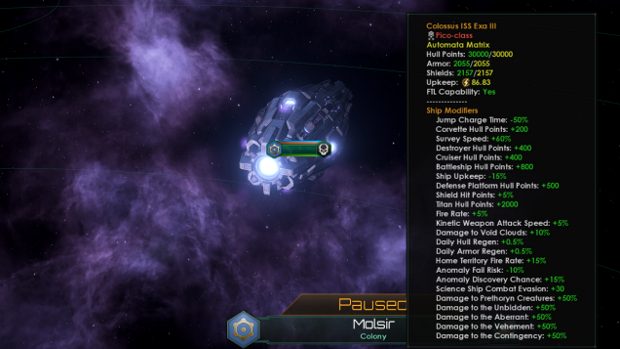Wot I Think: Stellaris - Apocalypse
Fresh start
I've made a lot of galaxies and star empires this last week, and I've thrown most of them in the bin. The Stellaris 2.0 update and the accompanying Apocalypse DLC have blown this 4X game to bits, along with my fleets as I've tried to wrap my head around the almost-new game built out of its chunks. Though I've racked up hundreds of hours of galactic conquest over the last couple of years, I've had to start fresh and figure out how to run a stellar empire all over again.
The xenophobic Imperium of Earth fell behind the rest of the galaxy and quickly found itself boxed in, the possessive but friendly Automata Matrix got squished in a war between Federations, and the slavers of the Saarlan Ravagers just weren't fun to play because they’re dicks. I should be a bit frustrated, but instead I'm hooked again. The DLC isn't essential, but the free update completely revitalises Stellaris, and it takes big risks to do it.
One of Stellaris' original selling points was that it presented a world liberally sprinkled with just about every sci-fi trope and technology imaginable. It's a multiverse of ideas, including everything from Xenomorphs to ringworlds, which is great from a roleplaying perspective, and that’s usually how I approach Stellaris. It's a strategy game, sure, but I'm less interested in winning than I am in telling the story of whatever species I've created. On that level it works marvelously but it can be bewildering when you’re just trying to figure out how to make an effective fleet, or when you want to plan a war that won’t leave you with a single planet to sit on to contemplate your mistakes.
Stellaris 2.0 scales back one of the earliest and most important choices you’ll make all game: your FTL method. Old Stellaris featured a trinity of FTL types, each dramatically changing - at least until the mid-game - how ships moved and empires expanded. Warp was the simplest, letting your ships travel in any direction, but not quickly. Wormholes made point-to-point travel possible, but only by constructing gateways that could be blown up by enemy fleets. Rounding them off was hyperlane technology, which let fleets travel quickly from system to system, but only down predetermined routes. Now everyone starts by using hyperlanes.
It’s bold. It’s driven fans of warp and wormholes to leave seething condemnations on Steam, predictably, but I’ll confess that I also felt a slight twinge of discontentment when I discovered someone was taking something away from me. The gall! That’s not quite the case, however. Wormholes are still dotted around the map, they’re just static, and you can make a galaxy with such a dense web of hyperlanes that it will seem like you’re using warp. Between the game settings and the tech tree, none of the diversity has been lost.
Here’s the rub: hyperlanes make wars better. When you know where enemy fleets could come from, because you can see the hyperlanes that connect the galaxy, you can prepare defences, station ships and build gargantuan floating citadels in strategic locations and chokepoints, knowing they’ll actually do some good.
Hyperlanes also make expansion more methodical, more like a puzzle. You’re not just trying to gobble up the largest, most habitable planets or the systems with the most resources, you’ve got to pick defensible locations and exploit the web to cut off enemies from the worlds and resources they need. With the old border system, it could be really hard to tell how your border would expand as outposts were built and the empire grew. It was all very muddy and arbitrary and lead to empires swallowing up planets that they didn’t even want. The starbase system clears most of that up.
Starbases are sort of all-purpose floating space stations. They can be massive weapons platforms, commercial centres, shipyards - their modular design means that they can be tailored for each system they operate inside. They also denote system ownership. Plonk down a starbase and you’ve got yourself a system, ready to be mined or colonised. You can have limitless outposts like these, but there are restrictions on how many you can upgrade and start customising. This means you can expand all you want, but you might not be able to keep your new sector for long if an armada comes calling.
If you’ve seen any developer diaries or interviews with game director Martin Anward, you’ll have heard the term “galactic terrain” a lot. My ears perked up every time he mentioned it because it’s what I consider one of the biggest obstacles in creating proper tactical battles. Space 4X games are at a distinct disadvantage when it comes to battlefields when compared to their land-bound cousins. Worlds have mountains and oceans and all these tactically rich and interesting places. Space is gassy. The abyss between stars remains a void in 2.0, but the star systems themselves now have an impact on fights. Duke it out in a system where there’s a pulsar, for instance, and every ship’s shields will be rendered useless.
So many of my first failed attempts were down to entirely forgetting about galactic terrain and sending my fleets into battles where they’d end up squashed in seconds, shields vanishing the moment they arrived near a pulsar. Shaking the monitor and yelling at the ceiling yielded no answers, but clicking on the star did. When I came across a pulsar again, I made a fleet of armoured ships that weren't reliant on shields and turned it into a stronghold.
The hyperlanes and galactic terrain also make putting together multiple fleets with various specialisations a very good idea. There are fleet size limits now to encourage this too. They can be overcome through research, but the game tries to teach you not to put all your eggs in one basket early on.
With more fleets flitting about, wars feel larger even though the same number of ships might be involved, and they’re certainly more complex. The AI seems more capable of handling multiple fronts and enemies, and they have no problem picking the right time to split up or regroup. Despite my low success rate so far, however, I never felt like I wasn’t able to manage the wars I found myself embroiled in.
Babysitting all these extra fleets is made a little less daunting by the one-stop-shop fleet manager. From there, you can assign admirals, review orders, reinforce fleets, build new ships… I don’t even want to remember my life without it. I once lost an actual yacht, in the real world, so as you can imagine, it’s not a stretch for me to lose a few pretend ships.
The new claim mechanic - which should be pretty familiar to any of you Paradoxian grand strategy lot - means that players and AI have to spend influence targeting specific star systems before they go to war, so that does mean you can generally predict where the enemy is going to strike. And they can’t really strike out of the blue. Instead of ultra-flexible wargoals that let them go to war for whatever reason they feel like, empires now need an excuse to fight. Oh yeah baby, it’s casus belli time.
If you’re playing a Barbaric Despoiler - think Firefly’s uncouth Reavers - then you can use the despoilation casus belli to plunder other empires, while Fanatical Purifiers --galactic exterminators, essentially - get a purification casus belli on every neighbouring empire. A casus belli gives you one or more wargoals, and ultimately these determine the focus of the conflict. So you’re not just trying to gobble up territory; you might be trying to stop your enemy from making a Colossus, or you might just fancy some extra slaves in the palace.
All these improvements to war and expansion do highlight what a pain in the arse it is to work with the AI. While there are plenty of diplomatic ways to engage with other empires, like working together on research treaties that require no actual interaction beyond sending a message, and there are still alliances and Federations, the AI is a terrible friend. I wonder if they’re too obsessed with their wargoals, because they certainly don’t want to help their human buddy. There’s nothing worse than watching as a 100,000-strength stack of ships is bearing down on you, and your pal, let’s call them the Tranquil Kithri Commonwealth, just sits there with more fleets than you can count and does nothing at all. I have all these new strategic options, and not one of them involves cooperation.
That I’m so far into this WIT and I haven’t mentioned a single paid feature from the DLC itself is probably quite telling, though I wouldn’t read into it too much. Apocalypse is a good addition to Stellaris, it just isn’t game-changing in the way that the free, 2.0 improvements are. It’s where all the cool and flashy stuff is kept, but it’s nothing I couldn’t live without.
However! You can build a Death Star, and that is definitely a lot of fun. Colossus class ships are ‘planet-killers’, but they’ve got a bad rap. Sure, some of them obliterate entire worlds, leaving their shards to the miners, but others can indoctrinate everyone on a planet or transform them all into cyborgs against their will, so it’s not all bad. It’s a very egalitarian approach to horrific weapons - there’s one for every type of megalomaniac.
Like the Titans, huge capital ships capable of wielding the new weapons, the Colossus vessels are end-game toys, and unless you’re playing a space arsehole, you might not get much use out of them even then. They’re empowering and such a big part of sci-fi that they fit right in, and gosh is it great to finally be able to assimilate whole worlds as my wholly original race of cyborgs, the Schmorg. But these additions alone can’t support a £15 expansion.
That’s where the Marauders come in, or at least where they should, but out of all Apocalypse’s additions they’ve left me the most lukewarm. Marauders are nomadic pirates who split their time between raiding colonies and fighting for the highest bidder. They’re meant to be a persistent threat that can turn into an end-game crisis if they band together, but they’re more like dudes on Twitter who threaten to beat you up and then you never hear from them again. They’ve appeared in every game I’ve played, but I’d be hard pressed to tell you what they did.
It’s a problem that Stellaris seems to have had since launch but that I’ve only really encountered now. I remember when we chatted about it on Three Moves Ahead (sorry, shameless plug) and I kept regaling Rowan Kaiser with all these wonderful stories of synthetic revolutions and gene wars, and he’d just sigh and tell me he’d seen almost none of that. There’s an element of luck involved in how fun and unpredictable your game will be, but experience tells me that there’s usually something diverting or exciting about to kick off. In the case of the Marauders, though, they seem more content to let the rest of the galaxy serve up compelling stories and huge battles, without necessarily involving themselves at all.
Still, I’d take Apocalypse with or without the Marauders, but either way it’s overshadowed by the 2.0 update. I have no idea how much more time or investment it takes to make something like Apocalypse compared to one of the story packs like Synthetic Dawn, but their impact on the game is about the same, even though Apocalypse is double the price.
The disparity between the free update and the DLC is even more pronounced than it was in Utopia, what with 2.0 representing such a massive overhaul of Stellaris’ foundations, and it’s even taken the Ascendency Perks from Utopia and made them free too. Paradox’s logic is that core systems, stuff that will inevitably be expanded on and tweaked, need to be free or the studio would have to support multiple, very different versions of the game. It’s sensible, generous even, but it’s also perfectly reasonable to be more hesitant about investing in DLC when that happens.
Stellaris has always been a bit better at the roleplaying, fantasy overlord stuff than the raw strategy and tactics side of things - which is a bit odd for a Paradox game - but with 2.0 it’s presenting a more balanced vision, where you can still play chill pacifist starfish who just want to be everyone’s friends, but when you do need to start kicking butts, war simply makes more sense and there are more ways to control it. And even if you manage to avoid conflict altogether (well done), the hyperlanes and starbases are a much more considered and deliberate way to plan and grow your empire.
There are going to be cries of ‘streamlining’ but, even if it wasn’t being used as a pejorative, it’s not quite accurate. I prefer ‘tidying up’. When you’re streamlining something, you’re cutting stuff away, smoothing out wrinkles and generally simplifying everything, but 2.0 doesn’t do that. Every part of Stellaris is still here; the pieces have just been rearranged, neatly.
I am a messy man. I’m absent-minded and cluttered. I’m probably one really bad month away from being a hoarder. But I’ve been trying to do a better job of pretending to be an adult, and keeping a structured and neat home is one of the ways I’ve randomly decided to do that. I must sound mad to functional human beings, but it’s been a revelation. My head’s clearer, I’m less stressed, I’m working more efficiently. That’s Stellaris 2.0. And boy am I glad nobody’s asking me to translate “like my newly tidy flat” into a number score
Stellaris 2.0 is a free update and it’s out now. Stellaris: Apocalypse is also out now on Steam and the Humble Store for £15.49/$19.99/€19.99.





